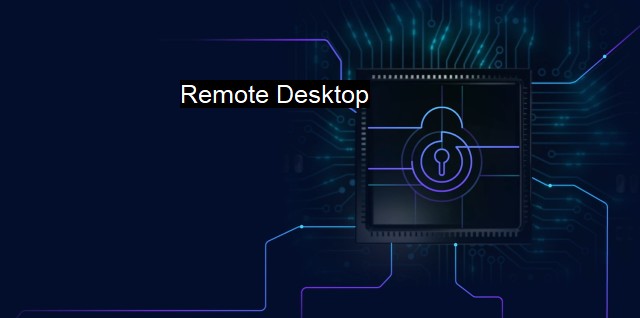What is Remote Desktop?
The Pros and Cons of Remote Desktop: Benefits and Vulnerabilities to IT Professionals and Cybersecurity
Remote Desktop refers to a technology that allows a user to connect and control another computer from a different location. It allows access and interaction with the remote computer, where applications can be opened and closed, data analyzed, and files created just as though the user was sitting directly in front of the remote machine. The screen of the remotely controlled computer is displayed on the computing device being used by the user. Under the context of cybersecurity and antivirus, remote desktop technology presents both opportunities and challenges.A significant advantage of remote desktop technology is that it allows IT professionals, especially cybersecurity experts, to provide immediate support when a security issue arises. Instead of having to guide a user through a problem over the phone or physically travel to a location, an IT specialist can access the system remotely. They can identify the issue firsthand and troubleshoot the settings or system files needed to fix the problem. IT staff can implement security updates or install antivirus software on all connected computers simultaneously. This ability drastically reduces the amount of time computers remain vulnerable to potential cyber-attacks.
Yet, remote desktop technology has potent cybersecurity implications that need to be handled carefully. Unauthorized or malevolent use of this technology can result in grave consequences. Hackers, for instance, could exploit vulnerabilities or weak points in a remote desktop protocol to gain control of an individual's computer. Once they've breached the system, they could steal sensitive information, install malicious software, or even lock administrators out of the network. It's easy to see why secure remote desktop protocols are vitally important.
One method for tightening security in remote desktop technology involves installing robust antivirus software. Well-rounded antivirus programs will have features that protect against unauthorized remote desktop interactions. These include firewalls to keep hackers at bay and filter out nonessential network communications, and intrusion detection or prevention systems (IDS/IPS) to monitor network activities for malicious behavior.
Applications or algorithms can also be implemented within the antivirus software to detect irregular activities, such as continuous failed login attempts, that may signal a cyber-attack. These alerts enable IT administrators to react swiftly by either providing stronger security measures, investigating the source, or temporarily shutting down access to the vulnerable computer.
A regular program of updates for both remote desktop systems and antivirus software is also essential. Cybercriminals are relentless in finding new ways to exploit and infiltrate systems. Hence, software companies continually develop patches and updates to strengthen protections and repair any identified vulnerabilities.
Establishing secure password policies and two-factor authentication can help ensure the integrity of remote desktop connections. Administrators should also maintain a policy of minimum necessary access—limiting remote control to just those who need it and restricting their access and editing power to only what is required for their role.
'remote desktop' is a beneficial technology with vast potential; it is not without risk. Through the mindful use of antivirus software and robust cybersecurity practices, these risks can be greatly mitigated. Be it in providing swift and effective IT assistance or conducting day-to-day business tasks; remote desktop technology, when partnered with solid cybersecurity practices, will continue to be an important tool in the digital world.

Remote Desktop FAQs
What is remote desktop and how does it relate to cybersecurity and antivirus?
Remote desktop is a technology that allows users to access their computers and data from another location. In terms of cybersecurity and antivirus, remote desktop can pose a threat if not properly secured. Hackers can exploit vulnerabilities in remote desktop software to gain unauthorized access to a system and steal sensitive data. It's important to use strong passwords, enable two-factor authentication, and keep remote desktop software up-to-date to minimize these risks.What are some best practices for securing remote desktop connections?
Some best practices for securing remote desktop connections include using strong passwords, disabling remote desktop access when not needed, limiting remote desktop access to specific users, enabling two-factor authentication, and using a virtual private network (VPN) to encrypt data transmitted between devices.What are some signs that my remote desktop connection may have been hacked?
Some signs that your remote desktop connection may have been hacked include unexpected changes to your computer settings, new software installations or changes to existing software, unusual network activity, and suspicious logins or login attempts. If you suspect that your remote desktop connection has been compromised, it's important to disconnect from the network immediately and seek assistance from a cybersecurity professional.What antivirus measures can I take to protect my remote desktop connection?
To protect your remote desktop connection from viruses and malware, you should ensure that your antivirus software is up-to-date and configured to scan all remote desktop sessions. It's also important to use a reputable antivirus program that includes features such as real-time scanning, automatic updates, and protection against known and unknown threats. Additionally, you should avoid clicking on suspicious links or downloading files from untrustworthy sources, which can introduce viruses and malware onto your system.| | A | | | B | | | C | | | D | | | E | | | F | | | G | | | H | | | I | | | J | | | K | | | L | | | M | |
| | N | | | O | | | P | | | Q | | | R | | | S | | | T | | | U | | | V | | | W | | | X | | | Y | | | Z | |
| | 1 | | | 2 | | | 3 | | | 4 | | | 7 | | | 8 | | |||||||